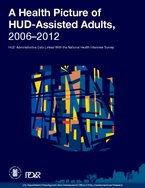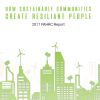0
Research
Community:
Jun 22, 2017
Alan E. Simon, Andrew Fenelon, Veronica Helms, Patricia C. Lloyd and Lauren M. Rossen, Health Affairs, 36, NO. 6 (June 2017): 1016–1023
Authored by:
Topics: Health, Medicaid / Medicare
 Shared by Steve Lucas
Shared by Steve Lucas
Steve Lucas posted a
on Jun 22, 2017
Abstract: "To investigate whether receiving US Department of Housing and Urban Development (HUD) housing assistance is associated with improved access to health care, we analyzed data on nondisabled adults ages 18–64 who responded to the 2004–12 National Health Interview Survey that were linked with administrative data from HUD for the period 2002–14.
Alan E. Simon, Andrew Fenelon, Veronica Helms, Patricia C. Lloyd and Lauren M. Rossen, Health Affairs, 36, NO. 6 (June 2017): 1016–1023
0
Research
Community:
Jun 22, 2017
Unprecedented descriptive analysis linking HUD administrative data and results from the National Health Interview Survey (pre-Affordable Care Act)
Authored by:
Topics: Affordable Care Act, Cost effectiveness, Dental, Depression, Exercise, Health, Healthy homes, Housing, Medicaid / Medicare, Mental health, Nutrition, Obesity, Research, Seniors, Smoke-free, Substance abuse
 Shared by Steve Lucas
Shared by Steve Lucas
Steve Lucas posted a
on Jun 22, 2017
From the Office of Policy Development and Research (PD&R) at the U.S. Department of Housing and Urban Development:
Unprecedented descriptive analysis linking HUD administrative data and results from the National Health Interview Survey (pre-Affordable Care Act)
0
Research
Community:
May 24, 2017
CSH reviewed more than 32 studies of supportive housing and compiled information about outcomes (housing, healthcare, and more). These reviews should be helpful for anyone looking to quantify particular impacts of housing. Please note that this review was not undertaken in an academic or systematic way; we make no claims about the strength of these evaluations or their findings.
Authored by: CSH
Topics: Health, Healthy homes, Homelessness, Housing, Supportive housing
 Shared by Steve Lucas
Shared by Steve Lucas
Steve Lucas posted a
on Jun 8, 2017
CSH reviewed more than 32 studies of supportive housing and compiled information about outcomes (housing, healthcare, and more). These reviews should be helpful for anyone looking to quantify particular impacts of housing.
0
Publication
Community:
Jun 8, 2017
A multi-faceted technical assistance resource for Public Housing Agencies and their partners who want to end homelessness. The Tookit is organized into five main sections: (1) Housing Choice Vouchers, (2) Public Housing, (3) Project-Based Vouchers, (4) Unique PHA Programs & Initiatives, (5) Primer on Homelessness ans Supportive Housing.
Authored by: Corporation for Supportive Housing (CSH)
Topics: Homelessness, Housing, Medicaid / Medicare, Partnerships, Substance abuse, Supportive housing
 Shared by Steve Lucas
Shared by Steve Lucas
Steve Lucas posted a
on Jun 8, 2017
Corporation for Supportive Housing (CSH)
A multi-faceted technical assistance resource for Public Housing Agencies and their partners who want to end homelessness.
0
Research
Community:
Mar 1, 2017
Authored by: The Public and Affordable Housing Research Corporation (PAHRC)
Topics: Education, Housing, Low-income, Post-secondary, Research, Workforce development
 Shared by Keely Stater
Shared by Keely Stater
Keely Stater posted a
on Jun 6, 2017
The Public and Affordable Housing Research Corporation (PAHRC)
0
Research
Community:
Jun 2, 2017
How Sustainable Communities Create Resilient People
Authored by: Public and Affordable Housing Research Corporation (PAHRC)
Topics: Community development
 Shared by Keely Stater
Shared by Keely Stater
Keely Stater posted a
on Jun 6, 2017
Public and Affordable Housing Research Corporation (PAHRC)
How Sustainable Communities Create Resilient People
1
News Article
Community:
May 25, 2017
Financial Incentive Offered to Multifamily Borrowers Incorporating Healthy Design Features in Affordable Housing
Authored by:
Topics: Health, Healthy homes
 Shared by Steve Lucas
Shared by Steve Lucas
Steve Lucas posted a
on May 25, 2017
WASHINGTON, DC – Fannie Mae (FNMA/OTC) announced today its Healthy Housing Rewards™ initiative aimed at providing a financial incentive for borrowers who incorporate healthy design features for newly constructed or rehabilitated affordable multifamily rental properties. Healthy Housing Rewards is one of several partnerships that Fannie Mae is advancing as part of a corporate-wide effort called Sustainable Communities Partnerships and Innovation.
Financial Incentive Offered to Multifamily Borrowers Incorporating Healthy Design Features in Affordable Housing
0
Video
Community:
May 19, 2017
Over the past decade, new research has revealed the link between early trauma and lifelong mental health issues. These discoveries have since revolutionized social work, healthcare, and early education. Policy changes enacted in response to our understanding of the biology of trauma are prioritizing earlier interventions like nurse home visiting services for at-risk families, and an increase in pre-kindergarten programs.
This short animation by Nadja Oertelt is part of The Atlantic’s Next America: Early Childhood project, which is supported by grants from the Annie E. Casey Foundation and the Heising-Simons Foundation.
Authored by: Nadja Oertelt for THE ATLANTIC
Topics: Child welfare, Cost effectiveness, Early childhood, Home visiting, Mental health, Research
 Shared by Abra Lyons-Warren
Shared by Abra Lyons-Warren
Abra Lyons-Warren posted a
on May 22, 2017
Nadja Oertelt for THE ATLANTIC
Over the past decade, new research has revealed the link between early trauma and lifelong mental health issues. These discoveries have since revolutionized social work, healthcare, and early education.
1
Report
Community:
May 1, 2017
State by State Chart
Authored by: ACF
Topics: Early childhood
 Shared by Marsha Basloe
Shared by Marsha Basloe
Marsha Basloe posted a
on May 4, 2017
2
Interactive
Community:
Feb 1, 2017
Suggestions for making supportive housing, both scattered site and single site, safe and developmentally appropriate for infants, toddlers, and preschoolers.
Authored by: ACF and CSH
Topics: Early childhood
 Shared by Marsha Basloe
Shared by Marsha Basloe
Marsha Basloe posted a
on May 4, 2017
Suggestions for making supportive housing, both scattered site and single site, safe and developmentally appropriate for infants, toddlers, and preschoolers.
1
Policy Brief
Community:
Apr 19, 2017
For eligible children, Medicaid pays for the medical services schools provide to students with disabilities so they can get an education.
Authored by:
Topics: Child welfare, Education, Medicaid / Medicare
 Shared by Steve Lucas
Shared by Steve Lucas
Steve Lucas posted a
on Apr 19, 2017
Medicaid provides affordable and comprehensive health coverage to over 30 million children. It also plays a little known but important role in supporting schools and making sure students, especially those with disabilities, get the care and services they need to succeed.
For eligible children, Medicaid pays for the medical services schools provide to students with disabilities so they can get an education.
0
Report
Community:
Feb 22, 2017
How Students Get to School in Denver, Detroit, New Orleans, New York City, and Washington, DC
Authored by: Student Transportation Working Group for the URBAN INSTITUTE
Topics: Education, Transportation
 Shared by Housing Is
Shared by Housing Is
Housing Is posted a
on Mar 29, 2017
Student Transportation Working Group for the URBAN INSTITUTE
How Students Get to School in Denver, Detroit, New Orleans, New York City, and Washington, DC
0
Report
Community:
Mar 2, 2017
In addition to detailing burdensome regulations, industry groups CLPHA, NAHRO, and PHADA raise concerns about recent MTW Notice and Comment solicitations.
Authored by: CLPHA, PHADA, and NAHRO
Topics: Housing
 Shared by Rich Bindell
Shared by Rich Bindell
Rich Bindell posted a
on Mar 3, 2017
In addition to detailing burdensome regulations, industry groups CLPHA, NAHRO, and PHADA raise concerns about recent MTW Notice and Comment solicitations.
2
News Article
Community:
Mar 2, 2017
Dr. Ben Carson becomes HUD Secretary with 58 to 41 vote in the Senate
Authored by:
Topics: Affordable Care Act, Funding, Health, Housing, Legislation & Policy
 Shared by Steve Lucas
Shared by Steve Lucas
Steve Lucas posted a
on Mar 2, 2017
On March 2, 2017 the U.S. Senate confirmed the nomination of Dr. Benjamin S. Carson, Sr. as the 17th Secretary of the U.S. Department of Housing and Urban Development by a 58 to 41 vote. Dr. Carson’s confirmation followed a relatively non-controversial nomination hearing in January and a straight-forward procedural vote in late February that advanced his nomination to the Senate floor.
Dr. Ben Carson becomes HUD Secretary with 58 to 41 vote in the Senate
0
Video
Community:
Dec 8, 2016
What's it like being a first-generation college student? Unlike most of their peers, they can't rely on the experience of parents and family to help them register for classes, fill out financial aid forms, or quickly adjust to their new lives on campus. These are the stories of several first-generation college students and graduates, and this video explores their challenges, sources of support, and recommendations for policymakers. With a third of all incoming college freshmen being first-generation, telling their stories and informing stakeholders is more important than ever.
Authored by: AMERICAN YOUTH POLICY FORUM
Topics: Education, Post-secondary
 Shared by Abra Lyons-Warren
Shared by Abra Lyons-Warren
Abra Lyons-Warren posted a
on Feb 22, 2017
AMERICAN YOUTH POLICY FORUM
What's it like being a first-generation college student? Unlike most of their peers, they can't rely on the experience of parents and family to help them register for classes, fill out financial aid forms, or quickly adjust to their new lives on campus.
0
Video
Community:
Feb 14, 2017
If a homeless student is worrying about where he is spending the night, it’s likely he’s not going to be thinking much about his homework. And in one of the poorest districts in Kansas, educators have realized that to help homeless students they needed to do more to help homeless families. Special correspondent Lisa Stark of Education Week traveled to Kansas City to explore their unique program.
Authored by: Lisa Stark for PBS NEWSHOUR
Topics: Education, Homelessness, Midwest
 Shared by Abra Lyons-Warren
Shared by Abra Lyons-Warren
Abra Lyons-Warren posted a
on Feb 17, 2017
Lisa Stark for PBS NEWSHOUR
If a homeless student is worrying about where he is spending the night, it’s likely he’s not going to be thinking much about his homework. And in one of the poorest districts in Kansas, educators have realized that to help homeless students they needed to do more to help homeless families.
0
Policy Brief
Community:
Feb 16, 2017
Supporting parents' efforts to help their children develop during the preschool years improves a child's school readiness, reduces behavior problems, enhances social skills, and promotes academic success.
Authored by: Bierman K, Morris P, and Abenavoli R for THE ROBERT WOOD JOHNSON FOUNDATION
Topics: Early childhood, Education, Family engagement, School-readiness
 Shared by Abra Lyons-Warren
Shared by Abra Lyons-Warren
Abra Lyons-Warren posted a
on Feb 16, 2017
Bierman K, Morris P, and Abenavoli R for THE ROBERT WOOD JOHNSON FOUNDATION
Supporting parents' efforts to help their children develop during the preschool years improves a child's school readiness, reduces behavior problems, enhances social skills, and promotes academic success.
0
Interactive
Community:
May 1, 2016
Authored by: CLPHA
Topics: CLPHA, Data sharing, Education, Housing, Metrics, Partnerships
 Shared by CLPHA Admin
Shared by CLPHA Admin
CLPHA Admin posted a
on Feb 7, 2017
We are pleased to share with you the following work product from the Council of Large Public Housing Authorities (CLPHA) as part of our Housing Is initiative, an effort to better intersect fields so they can more effectively help those they serve. This data sharing agreement template has been created in order to foster data sharing between housing and other sector organizations in order to improve efficiency, reduce duplication of efforts, and increase holistic care in order to improve educational and life outcomes for low-income children.
0
Webinar
Community:
Feb 1, 2017
An overview of the individual and employer-based insurance markets before and after the ACA, and a look ahead at the choices both insurers and consumers must make for 2018 and beyond.
For those unable to join the webinar and those who want to share the webinar with colleagues, a video of the webinar is now posted to the Alliance for Health Reform website, along with a transcript and all speaker presentations.
Authored by: Alliance for Health Reform and the National Institute for Health Care Management (NIHCM) Foundation, in collaboration with the Association of Health Care Journalists
Topics: Affordable Care Act
 Shared by Abra Lyons-Warren
Shared by Abra Lyons-Warren
Abra Lyons-Warren posted a
on Feb 6, 2017
Alliance for Health Reform and the National Institute for Health Care Management (NIHCM) Foundation, in collaboration with the Association of Health Care Journalists
An overview of the individual and employer-based insurance markets before and after the ACA, and a look ahead at the choices both insurers and consumers must make for 2018 and beyond.
0
News Article
Community:
Jan 25, 2017
A reading program designed to help men become better fathers is associated with better parenting skills as well as behavior and learning improvements in kids, a small study suggests.
Authored by: Lisa Rapaport for REUTERS
Topics: Early childhood, East Coast, Education, Family engagement, Literacy, School-readiness
 Shared by Abra Lyons-Warren
Shared by Abra Lyons-Warren
Abra Lyons-Warren posted a
on Feb 6, 2017
Lisa Rapaport for REUTERS
A reading program designed to help men become better fathers is associated with better parenting skills as well as behavior and learning improvements in kids, a small study suggests.
0
Research
Community:
Sep 1, 2014
Authored by: Greg J. Duncan and Katherine Magnuson for The Uninversity of Wisconsin-Madison Institute for Research on Poverty
Topics: Early childhood, Homelessness, Legislation & Policy, Low-income, School-readiness
 Shared by Amber-Lee Leslie
Shared by Amber-Lee Leslie
Amber-Lee Leslie posted a
on Jan 27, 2017
Greg J. Duncan and Katherine Magnuson for The Uninversity of Wisconsin-Madison Institute for Research on Poverty
0
Interactive
Community:
May 1, 2016
Authored by: CLPHA
Topics: CLPHA, Data sharing, Education, Housing, Metrics, Partnerships
 Shared by CLPHA Admin
Shared by CLPHA Admin
CLPHA Admin posted a
on Jan 24, 2017
We are pleased to share with you the following work product from the Council of Large Public Housing Authorities (CLPHA) as part of our Housing Is initiative, an effort to better intersect fields so they can more effectively help those they serve. This data sharing agreement template for use with intermediary organizations has been created in order to foster data sharing between housing and other sector organizations in order to improve efficiency, reduce duplication of efforts, and increase holistic care in order to improve educational and life outcomes for low-income children.
2
News Article
Community:
Aug 20, 2016
Why well-off black families end up living in poorer areas than white families with similar or even lower incomes.
Authored by: John Eligon and Robert Gebeloff for THE NEW YORK TIMES
Topics: Housing
 Shared by CLPHA Admin
Shared by CLPHA Admin
CLPHA Admin posted a
on Jan 5, 2017
John Eligon and Robert Gebeloff for THE NEW YORK TIMES
Why well-off black families end up living in poorer areas than white families with similar or even lower incomes.
0
Interactive
Community:
Nov 21, 2016
The Center for Neighborhood Technology’s Housing and Transportation (H+T®) Affordability Index provides a more comprehensive way of thinking about the true affordability of place. It presents housing and transportation data as maps, charts and statistics for 917 metropolitan and micropolitan areas—covering 94% of the US population. Costs can be seen from the regional down to the neighborhood level.
Authored by: CENTER FOR NEIGHBORHOOD TECHNOLOGY
Topics: Transportation
 Shared by CLPHA Admin
Shared by CLPHA Admin
CLPHA Admin posted a
on Nov 21, 2016
CENTER FOR NEIGHBORHOOD TECHNOLOGY
The Center for Neighborhood Technology’s Housing and Transportation (H+T®) Affordability Index provides a more comprehensive way of thinking about the true affordability of place.





















